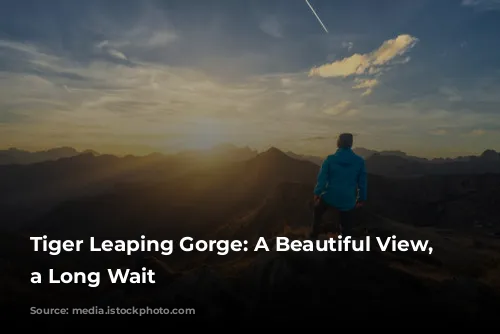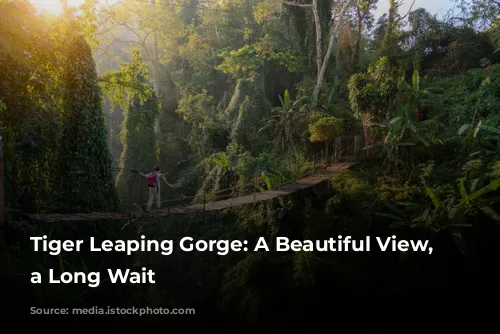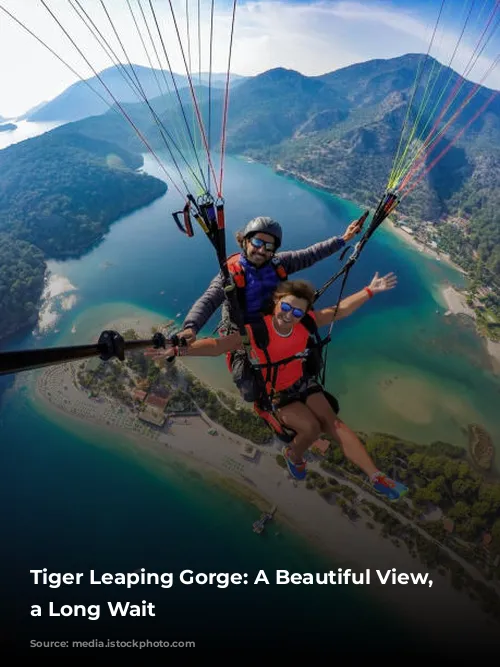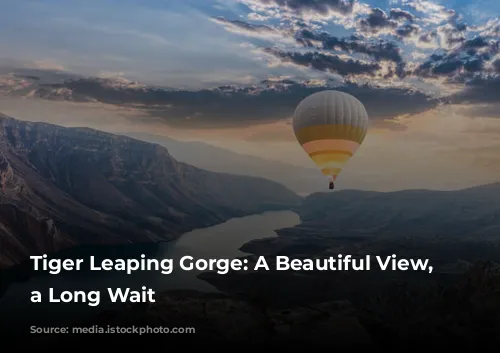The Tiger Leaping Gorge is truly a sight to behold, with breathtaking scenery that leaves you speechless. However, its beauty is often overshadowed by the frustrating management of the area. You might find yourself standing in line for two hours just to take a half-hour tour! It’s a real bummer, especially when you hear stories about the scenic bus being unavailable during off-season, leaving only a huge parking lot full of cars. Even if you’re lucky enough to be there during peak season, you’ll still find yourself waiting in long lines for the shuttle bus to take you to the main attractions.
The sheer number of people visiting the gorge makes it feel like a crowded marketplace, not a serene natural wonder. It’s a real shame that the authorities haven’t implemented better crowd control measures to ensure a more enjoyable experience for everyone. After all, who wants to spend two hours of their precious vacation time standing in a queue?

Balagezong Scenic Area: Worth It For the Shambhala Buddha, But Not Much Else
The Balagezong Scenic Area is a mountainous region with stunning views, but it’s not exactly a place for a leisurely stroll. The distances between attractions are considerable, making it difficult to explore the entire area in a single day. One of the main draws is the village of Bala Village, but unfortunately, there’s no one living there anymore. All that remains is the former residence of the road builder, which isn’t exactly a must-see.
There’s also the Barafota tower, but your time there is limited because you’re forced to use a shuttle bus. This means you have little time to truly enjoy the scenery. The whole experience feels rushed and doesn’t allow for much relaxation. The infrequent departure times for the shuttles make it even harder to see everything in a single day.
So, what’s the best part of Balagezong? Hands down, it’s the Shambhala Buddha. If you’re looking for a truly enriching experience, the Shambhala Buddha is worth the visit. However, if you’re hoping to enjoy a full day of exploring the area, you might be disappointed. The overall lack of things to do in Balagezong makes it feel like you’re paying for a ticket to a pretty view, but not much else.

Dukezong Ancient Town: A Window Into Tibetan History
The Dukezong Ancient Town is a fascinating glimpse into Tibetan history and culture. It’s the largest and best-preserved Tibetan settlement in China, and its story is as rich and colorful as its architecture.
The name “Dukezong” itself has a captivating origin. The word “Dukezong” is a Tibetan term that can mean “castle built on stone” or “moonlight city”. This evocative name is fitting, as the town sits atop the Big Turtle Mountain and was once a vital stop along the Ancient Tea Horse Road.
The Big Buddha Temple and the world’s largest prayer wheel are the two highlights of Dukezong. The temple, built during the Qing dynasty, offers stunning views of the surrounding mountains. The prayer wheel, a monument to Shangri-La’s renaming, is a breathtaking spectacle, showcasing the local culture and spirituality.
While the ancient city has preserved its charm, it’s also been transformed into a bustling tourist hub. Many of the traditional buildings now house shops, restaurants, and hotels. However, the genuine Tibetan character of the town remains, offering visitors a unique opportunity to experience the heart of Tibetan life.

Wu Di Hu: A Hidden Gem in Shangri-La
The Wu Di Hu, also known as the “Bottomless Lake”, is a hidden treasure in Shangri-La, just a short drive from Daocheng Aden. This beautiful lake, nestled in the heart of the Dilong Snow Mountain, is a must-see for anyone visiting the area. It boasts a breathtaking panorama that combines the beauty of Aden with the untouched natural landscapes of Shangri-La.
Wu Di Hu, meaning “Vardicuo” in Tibetan, is a plateau snow lake that sits at an impressive 3,800 meters above sea level. The surrounding scenery is breathtaking, with snow-capped mountains, lush forests, meadows, and grazing livestock creating a picture-perfect setting. The lake itself is a marvel, with crystal-clear water reflecting the snow-capped peaks and verdant foliage. Its vibrant blue hue adds to its allure, making it a photographer’s paradise.
The tranquil atmosphere and breathtaking views of Wu Di Hu offer a respite from the hustle and bustle of daily life. You can choose to hike around the lake, enjoying the stunning scenery of virgin forests, moss forests, and nomadic camps. The fresh air and beautiful surroundings are sure to refresh your mind and soul.

Haba Snow Mountain: A Challenge Worth Conquering
Haba Snow Mountain, the highest peak in the World Natural Heritage Reserve, is a challenging yet rewarding climb. It’s considered a “visual thermometer” by scientists, reflecting the health of the environment, and is also a sanctuary for rare and endangered species. The combination of steep canyons, rushing rapids, virgin forests, and glacial meadows makes it a truly unique and breathtaking destination.
While the climb isn’t for the faint of heart, it’s within reach for ordinary people who are physically fit and properly equipped. Many have climbed to the summit, making it a thrilling challenge for mountaineering enthusiasts.
This three-day adventure starts in Lijiang, taking you through the breathtaking Tiger Leaping Gorge before reaching Haba Village at the foot of the mountain. You’ll spend the first night at the Haba Inn, getting ready for the climb.
The second day involves a hike to the Base Camp, where you’ll enjoy dinner and get prepared for the final ascent. You’ll be joined by a professional alpine guide, who will ensure your safety and provide you with the necessary equipment.
Finally, the third day sees you wake up before dawn and ascend to the summit of Haba Snow Mountain. You’ll experience stunning views from the top, witnessing the beauty of the surrounding landscapes. After conquering the summit, you’ll descend back to Haba Village and return to Lijiang, carrying the memories of your incredible adventure.










